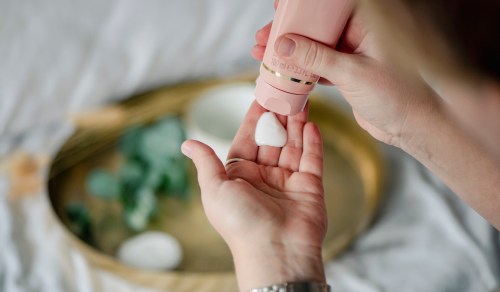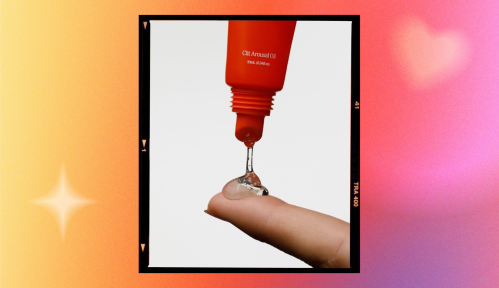Our editors independently select these products. Making a purchase through our links may earn Well+Good a commission
We (hopefully) all know by now that wearing sunscreen is a must-do for reducing the risk of skin cancer and UV damage, even on cloudy days, and especially if you’re going to be out in the sun. Most people have a sunscreen that they use if they’re on at the beach or spending a lot of time outdoors, and we’d guess that even more people have a product containing SPF that they use on their faces daily. But what about the hands? This is a part of the body that’s exposed almost all of the time, and it’s often overlooked when we talk about skin care, especially in terms of sun protection. Fortunately, there are several hand creams with SPF in addition to their hydrating ingredients to keep hands smooth, healthy, and protected.
Experts in This Article
cosmetic chemist
board-certified dermatologist and founder of Visha Skincare
board-certified dermatologist in Rhode Island
cosmetic chemist
Should all hand creams contain SPF?
It’s definitely a good choice to at least have one hand cream in your arsenal with SPF. We spoke with three experts about whether a hand cream that contains SPF is something to consider adding to a standard skin-care toolbox, and all three agreed—it’s worth it. “Personally with the constant LA sunshine, my hands would definitely say ‘yes!’ especially when you’re driving in LA traffic,” says cosmetic chemist and one-half of the duo known as Chemist Confessions, Victoria Fu. “From a formulation standpoint, hand cream formulas are thicker lotions that can definitely include SPF filters.”
With the future of our hands in mind, we’ve come up with a list of the best hand creams containing built-in sun protection from SPF. These hand creams range in price, size, and the benefits they offer, so be sure to consider your lifestyle, your needs, and your budget before making your purchase.
How much SPF is enough for hands?
Most dermatologists will agree that you should look for SPF 30 in any sunscreen—and that goes for hands, too. For the amount you should apply: About a dime-size dollop for each hand.
The best hand creams with SPF
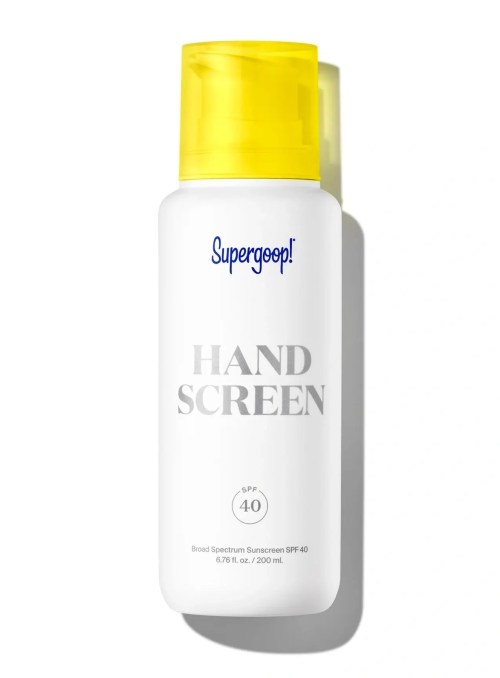
Supergoop!, Handscreen SPF 40 — $14.00
From one of the most beloved sunscreen brands, this hand cream offers a rich, protective product with a fairly high SPF to keep your hands safe, hydrated, and sun damage-free. Let’s talk about the sun protection factor first—it’s a broad-spectrum chemical sunscreen that uses Avobenzone, Octisalate, and Octocrylene to shield your skin from UVA and UVB rays, protecting them from sunburn, sun damage (like age spots), and skin cancer. Not only that, but it also hydrates the hands thanks to glycerin, natural oils, and antioxidants, the latter of which can also protect the skin from sun damage caused by free radicals from UV rays. You can pick this up in three sizes, but if you plan to wear it in the water be sure to cover it with a waterproof sunscreen or moisturizer to keep it from washing off.
Pros:
- High SPF coverage
- Hydrating
- Multiple sizes to choose from
Cons:
- Not waterproof

Hello Sunday, The One For Your Hands Hand Cream SPF 30 — $12.00
Hydrating, sun-protecting, and vegan, this hand cream from Hello Sunday is a great choice for anyone who’s looking to treat their hands with some moisturizing kindness while simultaneously protecting them from UV rays that we come in contact with every day.
“Ideally, hand cream should have SPF as hands are constantly exposed to the sun’s UV radiation,” says double board-certified dermatologist, Dr. Tiffany Libby. “Even while driving, UVA penetrates glass and can penetrate the skin to damage collagen and leads to signs of aging as well as increased risk of skin cancer.” Octocrylene, a chemical sunscreen ingredient, absorbs UVA and UVB rays, as well as blue light and infrared light, to keep the skin safe whatever your lifestyle. In addition to that, this cream contains hyaluronic acid and aloe vera to hydrate and moisturize the skin. Because this non-greasy sunscreen is formulated without the use of oxybenzone, octinoxate, and benzophenone, it’s safe for use in the ocean, and won’t harm coral reefs or wildlife found in the sea. To be honest, we couldn’t find many bad sides to this hand cream, except that it is scented with orange, musk, and floral notes, which may not be preferred by some.
Pros:
- Relatively low price point
- Vegan formula
- Ocean-safe
Cons:
- Lightly fragranced
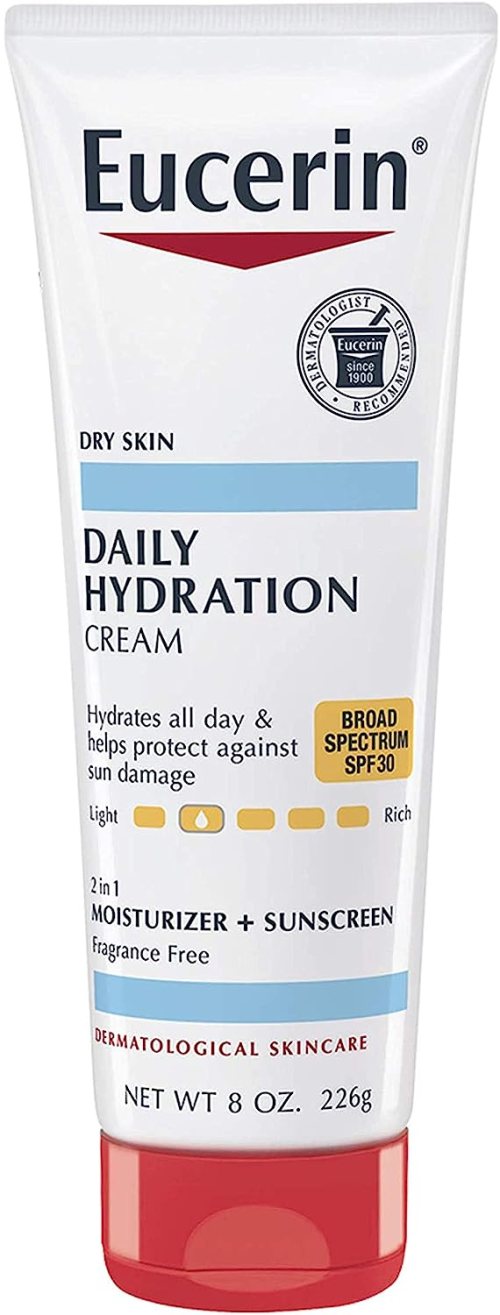
Eucerin, Daily Hydration Cream SPF 30 — $8.00
One of the most well-known names in the moisturizing game, Eucerin now offers this Daily Hydration Cream that contains moisturizers and sunscreen for the perfect bit of protection for your hands. This chemical sunscreen/hand cream combo contains a broad-spectrum SPF 30 to protect hands from harmful UV rays but doesn’t contain fragrances or dyes, so it’s a fantastic choice for sensitive hands in need of some sun shielding. Like all Eucerin products, this is a thick, rich hand cream that’s packed with moisturizing ingredients, including glycerin, and Hydrogenated Cocoglycerides, which is a combination of coconut oil and glycerin derivatives.
Pros:
- SPF 30
- Very moisturizing
- Great for sensitive skin
Cons:
- Contains a mild skin-lightening ingredient, Glycyrrhiza Inflata Root Extract
- Not water-resistant
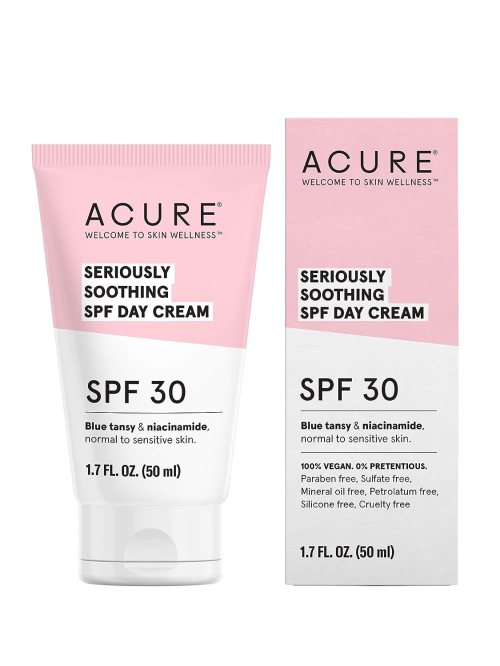
Acure, Seriously Soothing SPF 30 Day Cream — $17.00
Need a hydrating sunscreen that’s safe for sensitive skin and protective against harmful elements of the sun? This day cream from Acure contains an SPF of 30, and is made without parabens, sulfates, silicone, formaldehyde, and mineral oil, which are common skin irritators for many people. It’s certified cruelty-free and vegan, and uses zinc oxide to protect the skin from UV rays, making it a mineral sunscreen that’s easy on the skin but tough on sun damage. In addition to being protective, it also hydrates and soothes the skin thanks to aloe vera, niacinamide, argan oil, and shea butter, among other moisturizing ingredients.
Pros:
- Vegan, cruelty-free formula
- Very hydrating
Cons:
- May leave a white cast

Ducray, Melascreen Global Hand Care Photo-Aging SPF 50+ — $15.00
Loaded with the highest SPF of all the hand creams on this list so far, this rich, moisturizing hand cream from Ducray boasts an SPF of 50 to keep hands safe from UV rays, which can potentially lead to premature aging, sun damage, and skin cancer. “SPF 30 or higher should be used on the hands as well as all over the body,” says Dr. Patel.
“An even better option than lotions is opting for SPF gloves and arm protection sleeves.” If you can’t make driving gloves work, it’s OK—not only does this cream work to prevent sun-related symptoms of aging, but it’s also designed to correct the existing signs of sun damage, including hyperpigmentation, uneven skin tone, and fine line and wrinkles. This formula contains hyaluronic acid, C12-15 alkyl benzoate to seal in moisture, and BIS-Benzotriazolyl Tetramethylbutylpheno, a chemical ingredient that absorbs UVB and UVA rays to keep your skin safe, supple, and healthy.
Pros:
- Very high SPF content
- Corrects existing signs of sun damage
Cons:
- Contains fragrance
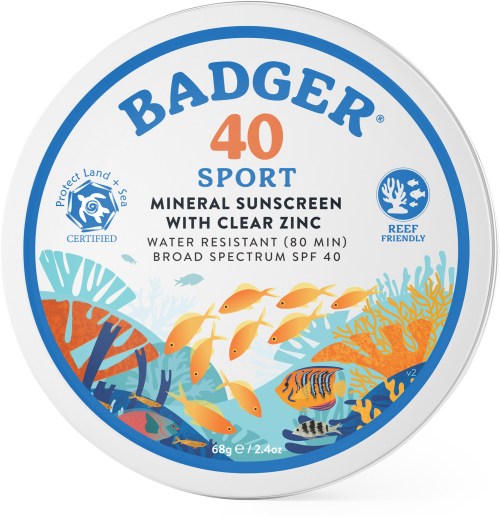
Badger, SPF 40 Protect Land & Sea Clear Zinc Sunscreen Cream Tin — $16.00
One of the most beloved brands in the salves and balm space, Badger now offers a mineral sunscreen cream that contains SPF. Because this cream needs to be warmed up in the hands to help the active ingredient, zinc oxide, lose some of its notorious white cast, it’s perfect for applying to the backs of the hands, the fingers, and the wrists if you need a hydrating way to shield your skin from the sun’s rays.
This SPF 40 formula is packed with 80 minutes of waterproof, broad-spectrum coverage, and because it’s made with organic, non-GMO ingredients, it’s safe for coral reefs and other marine life. To moisturize skin, it contains sunflower oil and sunflower vitamin E, and it’s topped with beeswax to seal all that goodness into the skin on your hands.
Pros:
- Ocean safe
- Waterproof
- Organic ingredients
Cons:
- May leave a white cast
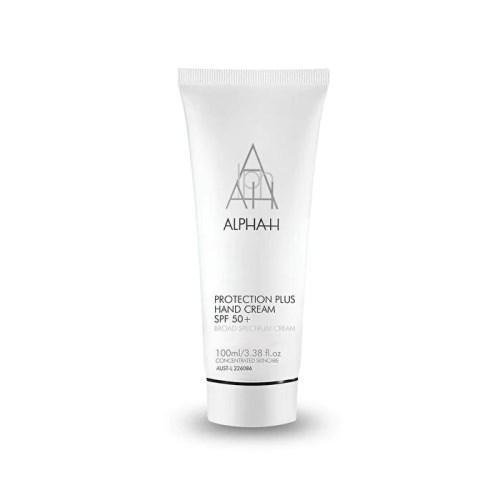
Alpha-H, Protection Plus Hand Cream SPF 50 — $52.00
Packed with an SPF of 50, this broad-spectrum chemical sunscreen in a hand cream is protective and hydrating. In addition to protecting the skin from UVA and UVB rays with octoceylene, it also reduces stress with vitamin C, which fights oxidation and is one of the best ingredients for preventing hyperpigmentation and other symptoms of sun damage. Vitamin E is another skin-loving ingredient in this cream, which is used to repair damage with it’s naturally antiinflammatory properties, as well as soothe, soften, and moisturize the hands. How much is enough to get adequate sun protection? “You’re roughly looking at a dime size amount for each hand,” says Fu. “Also just like any sunscreen, don’t forget to reapply every two hours!”
Pros:
- Broad spectrum
- High SPF
Cons:
- High price point
- Not ocean safe
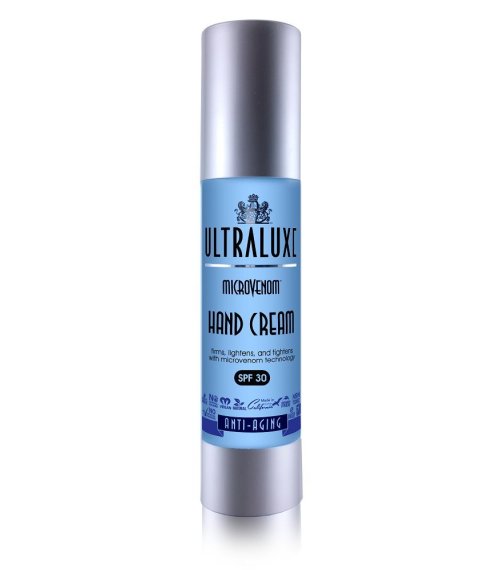
Ultraluxe Skin Care, Microvenom Hand Cream With SPF 30 — $35.00
This hand cream is hydrating and protective, with an SPF of 30, but the primary appeal of this cream seems to be treating existing signs of sun-related aging. It features mostly essential oils and fruit extracts to soften the skin, which can reduce the appearance of sun damage over time. In addition to that, it uses synthetic snake venom and apple stem cell technology to smooth out lines and wrinkles while evening out your skin’s tone and targeting all those other issues that make that statement about how your hands give away your age ring true.
This cream uses lemon fruit extract to offer a lightening effect on dark spots, which commonly appear on the tops of the hands due to continued sun exposure. For this reason, it may not be for everyone as it can lighten the skin surrounding those hyperpigmented areas, so assess wisely.
Pros:
- Reduces the appearance of existing sun damage
- Gentle ingredients that won’t irritate most skin types
Cons:
- High price point
- Contains a lightening agent
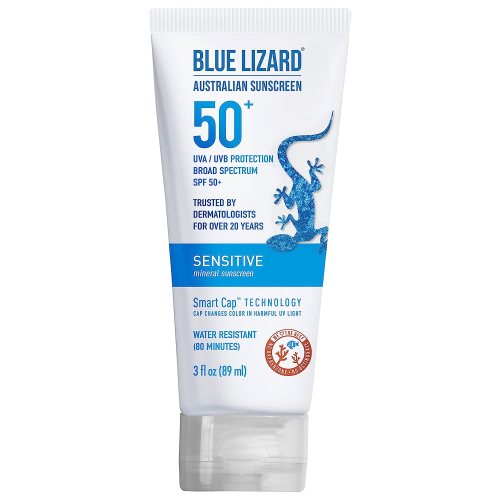
Blue Lizard, Sensitive Mineral Sunscreen Lotion SPF 50+ — $10.00
It’s not always easy to find a hand cream that contains SPF, in which case, a rich sunscreen can work just fine. “Hand cream may be a bit more hydrating or occlusive than one you may want to use on your face, but face and body SPF are perfectly fine to use on the hands, and this is often easier than carrying around a separate hand SPF just for the hands,” explains Dr. Libby.
You can protect your skin while keeping the ocean in mind at the same time when you use a reef-safe, mineral sunscreen like this one, from Blue Lizard. Offering 80 minutes of broad-spectrum sun protection, this SPF 50 sunscreen uses zinc oxide and titanium dioxide to block UVA/UVB rays, which can lead to, as previously mentioned, tons of harmful side effects. While it’s always recommended that you cover your skin anytime you’re outside or near a window, be that with clothing, an umbrella, or SPF, this sunscreen is fitted with a cap that turns blue when UV rays are present, which serves as a great reminder to cover up and protect yourself.
Pros:
- A great value for the price point
- Ocean-safe
- Fragrance-free
Cons:
- Not especially hydrating

Vacation, Classic Lotion SPF 30 Sunscreen — $12.00
There’s nothing like the scent of sunblock to transport us back to the beach, even if just in our heads. This lightly-scented chemical sunscreen lotion is leaning into that exact brand of nostalgia while also offering its wearers ample sun protection using avobenzone, homosalate, octisalate, and octocrylene. In addition to that, it’s formulated as a rich lotion that hydrates and soothes the skin, thanks to aloe vera, niacinamide, shea butter, and coconut oil. While this isn’t technically labeled as a hand cream, we included it on this list, at Dr. Libby’s recommendation, for its stellar list of ingredients and the great value you get for your money.
Pros:
- Very hydrating
- Great value for the money
Cons:
- Scented
What’s the difference between mineral and chemical sunscreen?
With both mineral and chemical sunscreens on this list, you may be asking yourself what the difference is between the two. Let’s look into it! “Mineral SPF products sit on top of your skin and UV rays bounce off rather than chemical SPF products, where the UV radiation is absorbed into the chemical block that is sitting on the skin,” says Purvisha Patel, MD, FAAD, board-certified dermatologist. “The UV rays dissipate once dissolved into the cream.”
How can you tell them apart? Look to the ingredients list. “Mineral sunscreen consists of inorganic compounds like titanium dioxide and zinc oxide,” says Dr. Libby. “Chemical sunscreen consists of organic compounds like avobenzone, oxybenzone, or octinoxate.” According to Gloria Lu, the other half of Chemist Confessions, you may also be able to tell them apart by how they appear on your skin. “Mineral filters are also powders, which can pose many formulation challenges such as leaving a white cast, drying skin feel, and heavy/tacky skin finish,” Lu explains. “Chemical filters are typically liquid, oil-based substances, which can provide more elegant textures. However, this category has been facing a lot of scrutiny and fear-mongering regarding safety and environmental impact. These concerns are usually taken out of context and not substantiated.”
So, they both protect the skin from UV rays, just in different ways…how can you tell which is the best type for you? “If you have oily or acne-prone skin, mineral sunscreen is a better option for you as they tend to be easier on the skin than chemical SPF products,” Dr. Patel adds. This may seem like it would only apply to sunscreen you’re applying to your face, but because many of us touch our faces more than we realize, it’s helpful to avoid pore-clogging ingredients that could rub off onto your face.
Sign up for the Well+Good SHOP Newsletter
Get exclusive deals on wellness, beauty, fitness, and food products that have been hand-picked by our editors.
Got it, you've been added to our email list.
